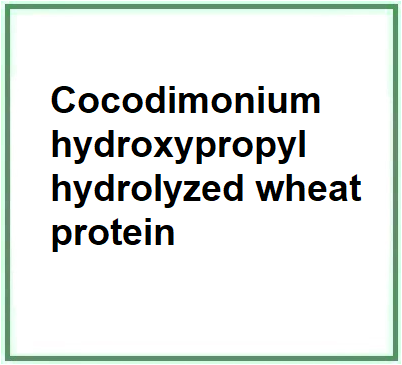Cocodimonium hydroxypropyl hydrolyzed wheat protein is a chemical compound of plant origin derived from coconut fatty acid and hydrolysed wheat protein.
The name describes the structure of the molecule:
- Cocodimonium is a quaternary ammonium compound derived from coconut oil. Quaternary ammonium compounds are often used in hair and skin care products for their conditioning properties.
- Hydroxypropyl is a chemical group derived from propylene glycol. It is often used in cosmetics and personal care products to improve the texture and feel of the product.
- Hydrolyzed wheat protein. It is a wheat protein that has been divided into smaller components, or peptides, through a process called hydrolysis. Hydrolyzed wheat protein is often used in hair and skin care products for its ability to retain moisture and add volume and smoothness.
The synthesis process takes place in different steps:
- Preparation. Wheat proteins, also known as gluten, are extracted from wheat flour by washing the wheat flour with water until all the starch granules have been removed and gluten remains.
- Hydrolysis of wheat proteins using an acid or enzyme to break them down into smaller peptide fragments.
- Propilation. Hydrolysed wheat proteins react with propylene oxide to introduce hydroxypropyl groups.
- Quaternization. Hydroxypropylated wheat proteins enter into a reaction with a quaternary ammonium compound, typically a tertiary amine derived from fatty acids such as cocodimonium chloride. This introduces cocodimonium groups, resulting in Cocodimonium Hydroxypropyl Hydrolyzed Wheat Protein.
It appears as a clear viscous liquid that is soluble in water. Compatible with both anionic, amphoteric and non-ionic surfactants.

What it is used for and where
Cosmetics
Cationic surfactant nourishing agent for hair and skin protection.
Antistatic agent. Static electricity build-up has a direct influence on products and causes electrostatic adsorption. The antistatic ingredient reduces static build-up and surface resistivity on the surface of the skin and hair.
Cleansing agent. Ingredient that cleanses skin without exploiting the surface-active properties that produce a lowering of the surface tension of the stratum corneum.
Hair conditioning agent. A significant number of ingredients with specific and targeted purposes may co-exist in hair shampoo formulations: cleansers, conditioners, thickeners, matting agents, sequestering agents, fragrances, preservatives, special additives. However, the indispensable ingredients are the cleansers and conditioners as they are necessary and sufficient for hair cleansing and manageability. The others act as commercial and non-essential auxiliaries such as: appearance, fragrance, colouring, etc. Hair conditioning agents have the task of increasing shine, manageability and volume, and reducing static electricity, especially after treatments such as colouring, ironing, waving, drying and brushing. They are, in practice, dispersants that may contain cationic surfactants, thickeners, emollients, polymers. The typology of hair conditioning agents includes: intensive conditioners, instant conditioners, thickening conditioners, drying conditioners. They can perform their task generally accompanied by other different ingredients.
Skin conditioning agent. It is the mainstay of topical skin treatment as it has the function of restoring, increasing or improving skin tolerance to external factors, including melanocyte tolerance. The most important function of the conditioning agent is to prevent skin dehydration, but the subject is rather complex and involves emollients and humectants that can be added in the formulation.
Surfactant - Cleansing agent. Cosmetic products used to cleanse the skin utilise the surface-active action that produces a lowering of the surface tension of the stratum corneum, facilitating the removal of dirt and impurities.
Dosage:
- balms 2.5% - 5.0'%
- shampoo, shower gel, cleansers 1.0% - 2.5%
- lotions 0,5% - 1.0%
- skin emulsions 0.25% - 0,5%
CAS 130381-04-3
| Appearance | Clear viscous lquid |
| pH | 6.5 - 7.5 |
| Dry matter | 30,0-32,0% (105°C) |
| Yeast & Molds | < 10 cfu/g |
![]() Cocodimonium hydroxypropyl hydrolyzed wheat protein
Cocodimonium hydroxypropyl hydrolyzed wheat protein 


